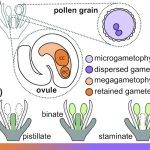Plant Science Research Weekly: May 12, 2023
Review: Climate change impacts on plant pathogens, food security, and paths forward
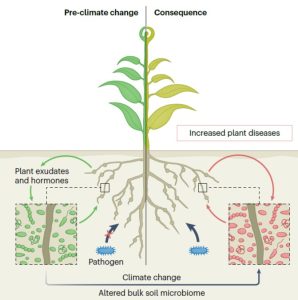 Much of what is written about the impacts of climate change on food production is focused on the abiotic stresses that plants will experience, but biotic stresses will be equally impactful, as discussed in this fine review by Singh et al. The challenges in predicting climate impacts on plant disease severity are complicated in part because the impacts on the abundance and virulence of the pathogen must be considered, as well the abundance and vigor (impacting defenses) of the plant host, global shifts in the distributions of plant and pathogen, and the impacts on the plant microbiome, which can promote or suppress disease. Furthermore, all these interactions are impacted by daytime temperatures, nighttime temperatures, water availability, elevated CO2 levels, and other abiotic factors. The authors outline several strategies to manage future disease outbreaks such as modified land management practices including the use of beneficial microbes; technical innovations including biochemical sensors and remote sensing tools, and science-policy interfaces for information sharing amongst farmers and through international organizations such as the Food and Agriculture Organization of the United Nations and CGIAR (Consultative Group for International Agricultural Research. (Summary by Mary Williams @PlantTeaching) Nat. Rev. Microbiol. 10.1038/s41579-023-00900-7
Much of what is written about the impacts of climate change on food production is focused on the abiotic stresses that plants will experience, but biotic stresses will be equally impactful, as discussed in this fine review by Singh et al. The challenges in predicting climate impacts on plant disease severity are complicated in part because the impacts on the abundance and virulence of the pathogen must be considered, as well the abundance and vigor (impacting defenses) of the plant host, global shifts in the distributions of plant and pathogen, and the impacts on the plant microbiome, which can promote or suppress disease. Furthermore, all these interactions are impacted by daytime temperatures, nighttime temperatures, water availability, elevated CO2 levels, and other abiotic factors. The authors outline several strategies to manage future disease outbreaks such as modified land management practices including the use of beneficial microbes; technical innovations including biochemical sensors and remote sensing tools, and science-policy interfaces for information sharing amongst farmers and through international organizations such as the Food and Agriculture Organization of the United Nations and CGIAR (Consultative Group for International Agricultural Research. (Summary by Mary Williams @PlantTeaching) Nat. Rev. Microbiol. 10.1038/s41579-023-00900-7
Review: Computer models of cell polarity establishment in plants
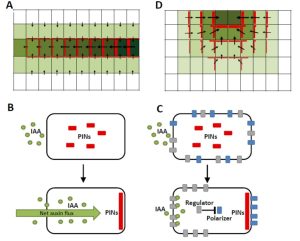 It’s pretty obvious that plants are not simply balls of cells. Their shapes and patterns are determined in large part through processes that cause cells to grow and divide asymmetrically, through the establishment of cell polarity. When I set out to read this review I was a bit nervous, expecting to be overwhelmed by differential equations. However, I was delighted to find it an accessible and fascinating look at the various ways we think about cell polarity in plants, with the added bonus of a description of how models are created and used to test these assumptions. It describes three main models for polarity establishment – auxin transport, mechanical forces, and cell division, along with the data that supports each model, and, helpfully, which cells and organs these models best fit (there is no one-size-fits all model). The review also points to current unknowns, and observes that most of these models are built and represent two-dimensional cell arrays, raising the question of how well they will fit 3D arrays and what else will we learn from 3D models? (Summary by Mary Williams @PlantTeaching) Plant Physiol. 10.1093/plphys/kiad264
It’s pretty obvious that plants are not simply balls of cells. Their shapes and patterns are determined in large part through processes that cause cells to grow and divide asymmetrically, through the establishment of cell polarity. When I set out to read this review I was a bit nervous, expecting to be overwhelmed by differential equations. However, I was delighted to find it an accessible and fascinating look at the various ways we think about cell polarity in plants, with the added bonus of a description of how models are created and used to test these assumptions. It describes three main models for polarity establishment – auxin transport, mechanical forces, and cell division, along with the data that supports each model, and, helpfully, which cells and organs these models best fit (there is no one-size-fits all model). The review also points to current unknowns, and observes that most of these models are built and represent two-dimensional cell arrays, raising the question of how well they will fit 3D arrays and what else will we learn from 3D models? (Summary by Mary Williams @PlantTeaching) Plant Physiol. 10.1093/plphys/kiad264
Regulation of hair cell and stomatal size by a hair-cell specific peroxidase in Brachypodium distachyon
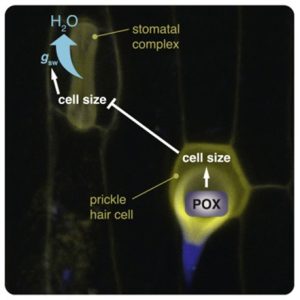 Mature grass leaves contain two specialized types of epidermal cells: stomata and epidermal hairs (trichomes). Stomatal pores are crucial for CO2 uptake and water conservation, while epidermal hairs contribute to water regulation and provide protection against UV-B light. If stomatal identity is not specified, hair cells can be formed instead in Brachypodium distachyon, while in maize, failure to specify hair cell identity can lead to the formation of ectopic stomata. This suggests that stomatal and epidermal hair cells are closely related, but the mechanism that coordinates their size and growth remains unknown. Nunes et al. used RNA-seq, reporting lines, gas exchange phenotyping, cell-wall composition analysis, and microscopy to investigate the regulatory mechanism underlying the growth of stomata and epidermal hairs in Brachypodium distachyon. They identified BdPRX76/BdPOX, a class III peroxidase, which is involved in hair cell and stomata size. BdPOX is expressed in elongating prickle hair cells (PHCs). In bdpox mutants, the prickle cells were smaller, and stomatal were longer, and the mutants showed a decrease in lignin content in the base of PHCs, suggesting that BdPOX plays a key role in coordinating the size of hair cells which indirectly affects stomatal size. Furthermore, the lignin content in the base of PHCs is important for proper growth. These findings open opportunities for further exploration of the feedback regulation between stomata and epidermal cells in grasses.(Summary by Andrea Gómez-Felipe @andreagomezfe) Curr. Biol. 10.1016/j.cub.2023.03.089
Mature grass leaves contain two specialized types of epidermal cells: stomata and epidermal hairs (trichomes). Stomatal pores are crucial for CO2 uptake and water conservation, while epidermal hairs contribute to water regulation and provide protection against UV-B light. If stomatal identity is not specified, hair cells can be formed instead in Brachypodium distachyon, while in maize, failure to specify hair cell identity can lead to the formation of ectopic stomata. This suggests that stomatal and epidermal hair cells are closely related, but the mechanism that coordinates their size and growth remains unknown. Nunes et al. used RNA-seq, reporting lines, gas exchange phenotyping, cell-wall composition analysis, and microscopy to investigate the regulatory mechanism underlying the growth of stomata and epidermal hairs in Brachypodium distachyon. They identified BdPRX76/BdPOX, a class III peroxidase, which is involved in hair cell and stomata size. BdPOX is expressed in elongating prickle hair cells (PHCs). In bdpox mutants, the prickle cells were smaller, and stomatal were longer, and the mutants showed a decrease in lignin content in the base of PHCs, suggesting that BdPOX plays a key role in coordinating the size of hair cells which indirectly affects stomatal size. Furthermore, the lignin content in the base of PHCs is important for proper growth. These findings open opportunities for further exploration of the feedback regulation between stomata and epidermal cells in grasses.(Summary by Andrea Gómez-Felipe @andreagomezfe) Curr. Biol. 10.1016/j.cub.2023.03.089
Precise integration of large DNA sequences in plant genomes using PrimeRoot editors
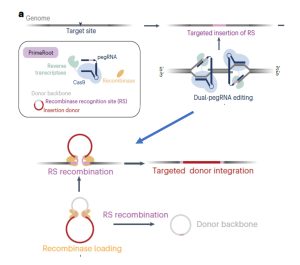 Although CRISPR/Cas9 tools have provided new opportunities for genome editing, using these systems to introduce large pieces of DNA has been challenging. A new genome editing technique, “PrimeRoot” (Prime editing-mediated Recombination Of Opportune Targets), was introduced by Sun et al. and shown to precisely insert large DNA donors/cargos in rice without double stranded break intermediates. The PrimeRoot technique uses plant-optimized guide RNA along with superior site-specific recombinases and an efficient plant prime editor. The authors surveyed the rice genome and found many genomic safe harbor sites, which are regions that can tolerate large insertions without adverse effects and are physically distant from gene coding regions, small RNAs, microRNAs, promoters, enhancers, long non-coding RNAs, etc. The use of optimized prime editing guide RNA (pegRNA) along with an enhanced plant prime editor led to insertion event efficiency of up to 50% in rice. Using this method, the authors were able to integrate a 4.9kb donor cassette comprising PigmR, which confers rice blast disease resistance, driven by the Actin1 promoter into one of the genomic safe harbor sites. The resulting plants showed significantly increased disease resistance, thus demonstrating PrimeRoot’s precision and efficiency for future molecular breeding efforts. (Summary by Indrani Kakati @indranikb) Nature Biotechnol. 10.1038/s41587-023-01769-w
Although CRISPR/Cas9 tools have provided new opportunities for genome editing, using these systems to introduce large pieces of DNA has been challenging. A new genome editing technique, “PrimeRoot” (Prime editing-mediated Recombination Of Opportune Targets), was introduced by Sun et al. and shown to precisely insert large DNA donors/cargos in rice without double stranded break intermediates. The PrimeRoot technique uses plant-optimized guide RNA along with superior site-specific recombinases and an efficient plant prime editor. The authors surveyed the rice genome and found many genomic safe harbor sites, which are regions that can tolerate large insertions without adverse effects and are physically distant from gene coding regions, small RNAs, microRNAs, promoters, enhancers, long non-coding RNAs, etc. The use of optimized prime editing guide RNA (pegRNA) along with an enhanced plant prime editor led to insertion event efficiency of up to 50% in rice. Using this method, the authors were able to integrate a 4.9kb donor cassette comprising PigmR, which confers rice blast disease resistance, driven by the Actin1 promoter into one of the genomic safe harbor sites. The resulting plants showed significantly increased disease resistance, thus demonstrating PrimeRoot’s precision and efficiency for future molecular breeding efforts. (Summary by Indrani Kakati @indranikb) Nature Biotechnol. 10.1038/s41587-023-01769-w
Improved soybean photosynthesis and yield by accelerating recovery from photoprotection
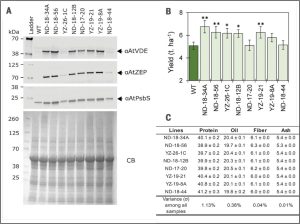 Enhancing crop yield for future food supplies involves increasing photosynthetic efficiency, which can be achieved by improving photoprotection through non-photochemical quenching (NPQ). NPQ enables leaves to dissipate excess absorbed light energy as heat, minimizing the negative effects of photodamage. Upon transition to shade conditions, the photoprotective mechanism relaxes, allowing the plants to make full use of the limited light they capture. The photoprotection process is regulated by components of the xanthophyll cycle like violaxanthin de-epoxidase (VDE), zeaxanthin epoxidase (ZEP), and Photosystem II (PSII) subunit S (PsbS). The major limitation of this mechanism is that upon transition to shade it relaxes slowly, which significantly lowers the photosynthetic efficiency of the plant. In this study, De Souza et. al. optimized the regulation of photoprotection in soybean through bioengineering to increase photosynthetic efficiency. The authors targeted three important components of xanthophyll cycle, VDE, PsbS, and ZPE, that are the key regulators of NPQ induction and relaxation. Transgenic soybean plants overexpressing Arabidopsis VDE, PsbS, and ZEP proteins showed a more rapid NPQ relaxation compared to the non-transgenic background upon transition to shade and up to 33% more seed yield. The study, together with a previous such study in tobacco, opens avenues for increasing crop yield by targeting improved photosynthetic efficiency via optimized photoprotection of the photosynthetic machinery under light fluctuations. (Summary by Mahesh Kumar Panda @maheshkumarMnP) Science 10.1126/science.adc9831
Enhancing crop yield for future food supplies involves increasing photosynthetic efficiency, which can be achieved by improving photoprotection through non-photochemical quenching (NPQ). NPQ enables leaves to dissipate excess absorbed light energy as heat, minimizing the negative effects of photodamage. Upon transition to shade conditions, the photoprotective mechanism relaxes, allowing the plants to make full use of the limited light they capture. The photoprotection process is regulated by components of the xanthophyll cycle like violaxanthin de-epoxidase (VDE), zeaxanthin epoxidase (ZEP), and Photosystem II (PSII) subunit S (PsbS). The major limitation of this mechanism is that upon transition to shade it relaxes slowly, which significantly lowers the photosynthetic efficiency of the plant. In this study, De Souza et. al. optimized the regulation of photoprotection in soybean through bioengineering to increase photosynthetic efficiency. The authors targeted three important components of xanthophyll cycle, VDE, PsbS, and ZPE, that are the key regulators of NPQ induction and relaxation. Transgenic soybean plants overexpressing Arabidopsis VDE, PsbS, and ZEP proteins showed a more rapid NPQ relaxation compared to the non-transgenic background upon transition to shade and up to 33% more seed yield. The study, together with a previous such study in tobacco, opens avenues for increasing crop yield by targeting improved photosynthetic efficiency via optimized photoprotection of the photosynthetic machinery under light fluctuations. (Summary by Mahesh Kumar Panda @maheshkumarMnP) Science 10.1126/science.adc9831
Shade finds a salty connection
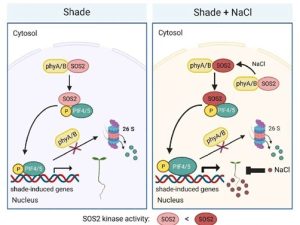 Light acts as a crucial signal for plant growth and development and is perceived by several types of photoreceptors including phytochromes (phys). Sun-loving plants often exhibit shade avoidance syndrome (SAS), like longer hypocotyl, lesser branching, and earlier flowering to outcompete their neighbors for light. Shade-induced elongation is mediated by the action of PHYTOCHROME INTERACTING FACTORs (PIFs), which are less abundant in light when phytochrome B (phyB) is active, and more abundant in shade when phyB is less active. Han et al. showed that SALT OVERLY SENSITIVE2 (SOS2), a salt stress signal transducer, promotes SAS in Arabidopsis. SOS2 is a protein kinase that phosphorylates PIF4 and PIF5, which both increases their level of protein accumulation and weakens the antagonistic activity of phyB on PIFs. Thus, although salt limits cell elongation, the interaction between SOS2 and PIF4 and PIF5 helps to sustain growth in the shade. In a related paper, the same research group also showed that phytochromes enhance SOS2-mediated PIF1 and PIF3 phosphorylation and degradation to promote salt tolerance. Together, these studies show that through interactions with different PIFs, plants benefit from salt- and light-activated SOS2, which not only boosts plant tolerance to salt but also encourages plant adaptation to shade. (Summary by Rajarshi Sanyal, @rajarshi_sanyal) Plant Cell, 10.1093/plcell/koad119 and 10.1093/plcell/koad117.
Light acts as a crucial signal for plant growth and development and is perceived by several types of photoreceptors including phytochromes (phys). Sun-loving plants often exhibit shade avoidance syndrome (SAS), like longer hypocotyl, lesser branching, and earlier flowering to outcompete their neighbors for light. Shade-induced elongation is mediated by the action of PHYTOCHROME INTERACTING FACTORs (PIFs), which are less abundant in light when phytochrome B (phyB) is active, and more abundant in shade when phyB is less active. Han et al. showed that SALT OVERLY SENSITIVE2 (SOS2), a salt stress signal transducer, promotes SAS in Arabidopsis. SOS2 is a protein kinase that phosphorylates PIF4 and PIF5, which both increases their level of protein accumulation and weakens the antagonistic activity of phyB on PIFs. Thus, although salt limits cell elongation, the interaction between SOS2 and PIF4 and PIF5 helps to sustain growth in the shade. In a related paper, the same research group also showed that phytochromes enhance SOS2-mediated PIF1 and PIF3 phosphorylation and degradation to promote salt tolerance. Together, these studies show that through interactions with different PIFs, plants benefit from salt- and light-activated SOS2, which not only boosts plant tolerance to salt but also encourages plant adaptation to shade. (Summary by Rajarshi Sanyal, @rajarshi_sanyal) Plant Cell, 10.1093/plcell/koad119 and 10.1093/plcell/koad117.
Photo-thermally controlled transcriptional regulation of FLOWERING LOCUS T drives the arrest of flowering time in Arabidopsis
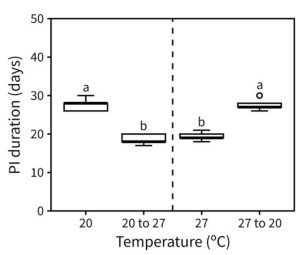 Light and temperature are important external signals required by plants for flower initiation. These external signals along with some internal cues (plant age, gibberellins, etc.) are established factors for floral initiation, but the factors required for end-of-flowering time are not yet established. González-Suárez et al. discovered that an increase in day length and higher temperature during flowering promotes floral meristem initiation, which in turn acts as a cue for end-of-flowering time in Arabidopsis thaliana. This process was found to be mediated by the expression of FLOWERING LOCUS T (FT), an activator of floral development, which increases during flowering and peaks during inflorescence meristem arrest. Understanding the role of FT as an important regulator of end-of-flowering, which precedes fruit set, could help in understanding how global warming would impact end-of-flowering time in crops. (Summary by Idowu Arinola Obisesan @IdowuAobisesan) Plant Physiol.10.1093/plphys/kiad163
Light and temperature are important external signals required by plants for flower initiation. These external signals along with some internal cues (plant age, gibberellins, etc.) are established factors for floral initiation, but the factors required for end-of-flowering time are not yet established. González-Suárez et al. discovered that an increase in day length and higher temperature during flowering promotes floral meristem initiation, which in turn acts as a cue for end-of-flowering time in Arabidopsis thaliana. This process was found to be mediated by the expression of FLOWERING LOCUS T (FT), an activator of floral development, which increases during flowering and peaks during inflorescence meristem arrest. Understanding the role of FT as an important regulator of end-of-flowering, which precedes fruit set, could help in understanding how global warming would impact end-of-flowering time in crops. (Summary by Idowu Arinola Obisesan @IdowuAobisesan) Plant Physiol.10.1093/plphys/kiad163
Re-imagining reproduction: The Queer possibilities of plants
 Male – female, egg – sperm: how did these animal-centric terms come to be applied to plants? This question is addressed in this interesting essay by Subramaniam and Bartlett. As they observe, the language we use to talk about plant reproduction is largely rooted in the language of animal reproduction, and reflects the conventions and ideas of those who assigned these terms. For example, Linnaeus used terms like marriage, husband, and wife (and referred to petals as “bridal beds”!) when writing about plant reproduction. Subramaniam and Bartlett point out that these ideas and terms don’t match up well with plant reproduction. For example, the concept of individuals having a distinct gender doesn’t work when 85% of flowering plants produce flowers with both “male” and “female” parts. The authors provide many other examples that demonstrate that “Plant reproductive biology poorly fits a model of binary sex, gender, and sexuality.” To move away from this model, they propose some modifications to conventional terminology, such as meiotic reproduction rather than sexual reproduction, and dispersed gametes and retained gametes rather than sperm cells and egg cells. (Summary by Mary Williams @PlantTeaching) Integr. Comp. Biol. 10.1093/icb/icad012
Male – female, egg – sperm: how did these animal-centric terms come to be applied to plants? This question is addressed in this interesting essay by Subramaniam and Bartlett. As they observe, the language we use to talk about plant reproduction is largely rooted in the language of animal reproduction, and reflects the conventions and ideas of those who assigned these terms. For example, Linnaeus used terms like marriage, husband, and wife (and referred to petals as “bridal beds”!) when writing about plant reproduction. Subramaniam and Bartlett point out that these ideas and terms don’t match up well with plant reproduction. For example, the concept of individuals having a distinct gender doesn’t work when 85% of flowering plants produce flowers with both “male” and “female” parts. The authors provide many other examples that demonstrate that “Plant reproductive biology poorly fits a model of binary sex, gender, and sexuality.” To move away from this model, they propose some modifications to conventional terminology, such as meiotic reproduction rather than sexual reproduction, and dispersed gametes and retained gametes rather than sperm cells and egg cells. (Summary by Mary Williams @PlantTeaching) Integr. Comp. Biol. 10.1093/icb/icad012



